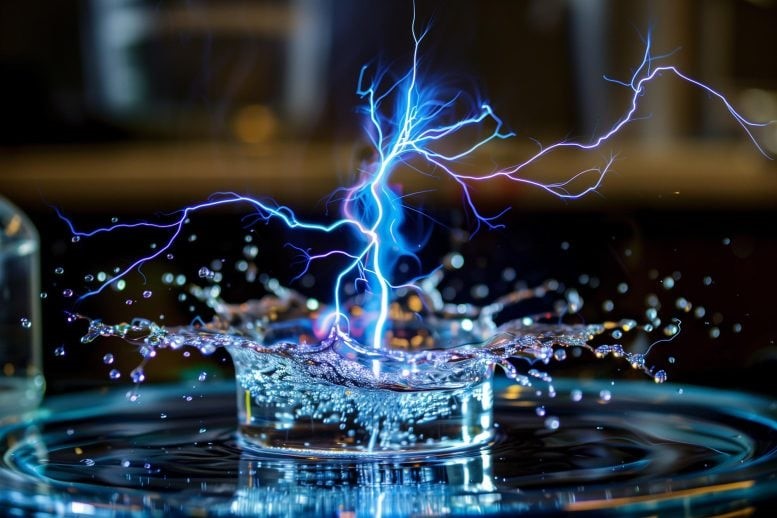Water Droplets Are Producing Electricity in a Newly Discovered Way
This newfound insight into water's "stick-slip" motion paves the way for designing surfaces that regulate electrification, with potential applications in safer fuel storage, enhanced energy storage, and improved charging efficiency.

Figure 1. New Discovery: Water Droplets Generating Electricity.
The Untapped Electrical Potential of Water
"Most people might notice rainwater trickling down a window or car windshield without realizing it generates a small electrical charge," said Sherrell, a researcher at RMIT’s School of Science specializing in harnessing ambient energy from the environment. Figure 1 shows New Discovery: Water Droplets Generating Electricity.
"Until now, scientists believed this charge formed when liquid left a surface, transitioning from wet to dry. However, our study reveals that charge is also created at the moment water first touches a surface—when it goes from dry to wet—with a strength ten times greater than previously understood.
"Crucially, this charge doesn’t simply vanish. While we haven’t pinpointed its exact location, our findings suggest it originates at the interface and likely remains in the droplet as it moves."
Berry, a fluid dynamics expert from the University of Melbourne’s Department of Chemical Engineering, emphasized the safety implications of charge buildup, particularly in fuel storage. "An electric shock inside a container of flammable liquid could be hazardous, so it’s critical to safely discharge any residual charge after the liquid moves away."
"As we transition to new renewable fuels, understanding how and why electric charge forms during liquid flow over surfaces becomes increasingly important," Berry added. "Current methods to minimize charge buildup—such as flow restrictions and additives—may not work effectively with emerging fuels. This research could help us design coatings that manage or dissipate charge safely in next-generation fuel systems."
Teflon and Water: An Unexpected Electrical Interaction
In their study published in Physical Review Letters, researchers explored the surprising charging effect between water and polytetrafluoroethylene (PTFE)—the material commonly known as Teflon. While Teflon is frequently used in pipes and fluid-handling systems, it does not conduct electricity, making it difficult to safely dissipate the charge that builds up.
Measuring Water’s Electrical Charge
To investigate this phenomenon, the team examined how water droplets spread and contract on a flat Teflon surface, simulating real-world droplet movement. Using a specialized camera, they captured individual frames of droplets as they stuck and slipped across the surface, while simultaneously measuring changes in electrical charge.
“We were fortunate to have three outstanding Chemical Engineering master’s students assist in setting up and conducting these experiments as part of their coursework at the University of Melbourne,” said Berry.
Breakthrough Findings in Electrical Charge Measurement
Shuaijia Chen, the study’s first author and a PhD student at the University of Melbourne, revealed that the most significant charge shift occurred the moment water first made contact with the surface, jumping from 0 to 4.1 nanocoulombs (NC).
As the water alternated between wet and dry phases, the charge fluctuated between approximately 3.2 and 4.1 NC.
“To put this into perspective, the electrical charge generated by water moving over the PTFE surface is more than a million times smaller than the static shock you might feel when someone jumps near you on a trampoline,” Chen explained.
“While this may seem insignificant, this discovery opens the door to innovations that could enhance or suppress charge generation in liquid-surface interactions for various real-world applications.”
The Future of Water-Based Electricity
The researchers believe their findings could lead to commercial advancements, depending on collaborations with industry partners.
Looking ahead, the team plans to study the stick-slip effect in different liquids and surface materials.
“The charge magnitude and rate in other liquid-surface interactions could have important implications for a wide range of commercial applications,” Sherrell noted.
“We aim to explore how stick-slip motion influences the safety design of fluid handling systems, including those used for storing and transporting ammonia and hydrogen. Additionally, we will investigate methods to harness this effect for electricity recovery and faster charging in energy storage devices.”
Source: SciTECHDaily
Cite this article:
Priyadharshini S (2025),”Water Droplets Are Producing Electricity in a Newly Discovered Way", AnaTechmaz, pp.1109

